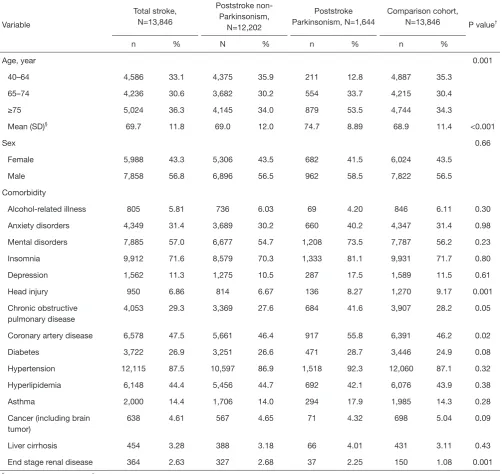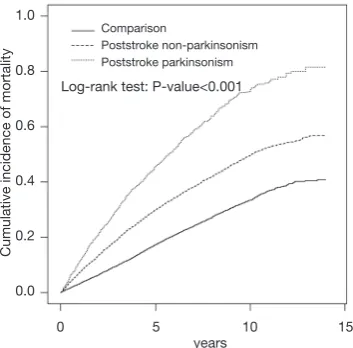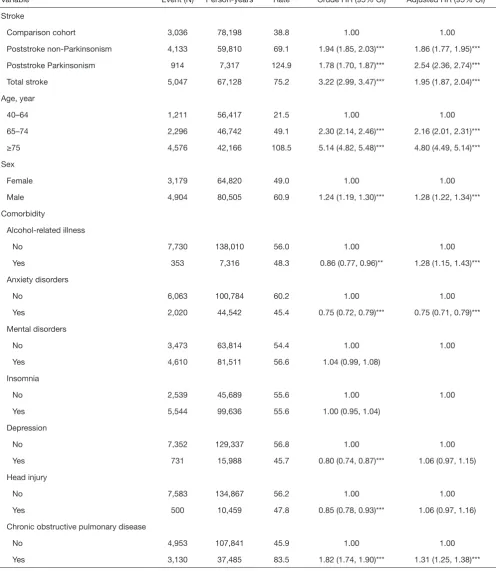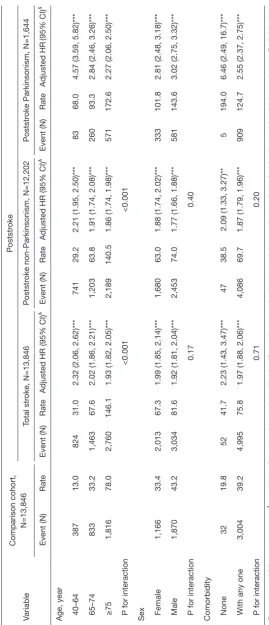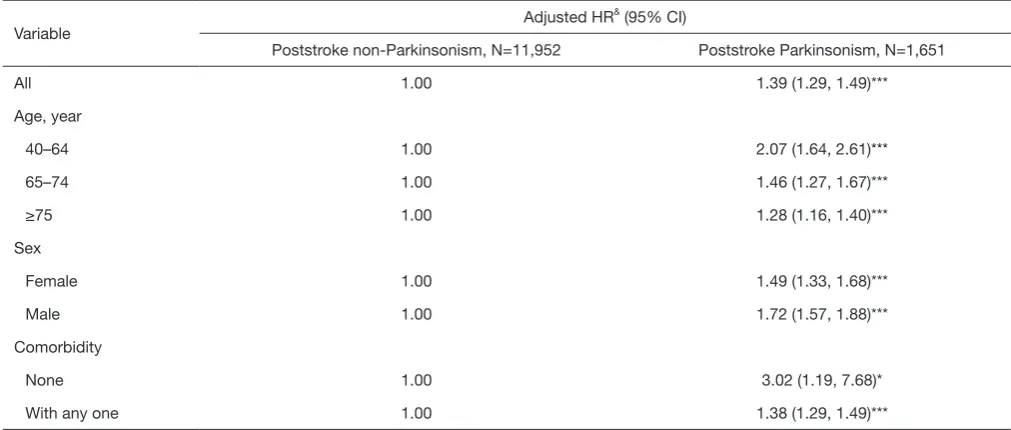Page 1 of 10
Poststroke Parkinsonism associates with an increased mortality
risk in patients
Dorji Harnod1,2, Tomor Harnod3,4, Cheng-Li Lin5,6, Chung Y. Hsu7, Chia-Hung Kao7,8,9,10
1Department of Emergency and Critical Care Medicine, Fu Jen Catholic University Hospital, Fu Jen Catholic University, New Taipei City; 2School of Medicine, College of Medicine, Fu Jen Catholic University, New Taipei City; 3Department of Neurosurgery, Hualien Tzu Chi Hospital, Buddhist Tzu Chi Medical Foundation, Hualien; 4College of Medicine, Tzu Chi University, Hualien; 5Management Office for Health Data, China Medical University Hospital, Taichung; 6College of Medicine, 7Graduate Institute of Biomedical Sciences, China Medical University, Taichung; 8Center of Augmented Intelligence in Healthcare, 9Department of Nuclear Medicine and PET Center, and Center of Augmented Intelligence in Healthcare, China Medical University Hospital, Taichung; 10Department of Bioinformatics and Medical Engineering, Asia University, Taichung
Contributions: (I) Conception and design: D Harnod, T Harnod, CH Kao; (II) Administrative support: None; (III) Provision of study materials or patients: CH Kao; (IV) Collection and assembly of data: All authors; (V) Data analysis and interpretation: All authors; (VI) Manuscript writing: All authors; (VII) Final approval of manuscript: All authors.
Correspondence to: Chia-Hung Kao, MD. Graduate Institute of Clinical Medicine Science and School of Medicine, College of Medicine, China Medical University, No. 2, Yuh-Der Road, Taichung 404. Email: d10040@mail.cmuh.org.tw; dr.kaochiahung@gmail.com; Tomor Harnod, MD. Department of Neurosurgery, Hualien Tzu Chi Hospital, Buddhist Tzu Chi Medical Foundation, 707, Sec. 3, Chung-Yang Road, Hualien 970. Email: nsha@tzuchi.com.tw.
Background: To determine whether poststroke Parkinsonism (PSP) increases mortality risk in poststroke patients by using Taiwan National Health Insurance Research Database (NHIRD).
Methods: We analyzed NHIRD data of ≥40-year-old patients diagnosed as having stroke [International Classification of Disease, Ninth Revision, Clinical Modification (ICD-9-CM) codes 430-438] between 2000 and 2013. Poststroke patients were divided into those with subsequent PSP (ICD-9-CM codes 332, 332.0, and 332.1) and without PSP (non-Parkinsonism, PSN) cohorts, all compared with a sex-, age-, comorbidity-, and index date-matched comparison cohort. We calculated adjusted hazard ratios (aHRs) and 95% confidence intervals (CIs) of all-cause mortality risk in these cohorts after adjustments for age, sex, and comorbidities.
Results: PSP was noted in 11.87% (1,644/13,846) of poststroke patients. In the PSN, PSP, and comparison cohorts, mortality incidence rates were 69.1, 124.9, and 38.8 per 1,000 person-years, respectively. Compared with the comparison cohort, the mortality risks in patients aged 40 to 64, 65 to 74, and ≥75 years were respectively 2.21-, 1.91-, and 1.86-fold higher mortality risks in the PSN cohort and 4.57-, 2.84-, and 2.27-fold higher mortality risks in the PSP cohort. Male sex further increased mortality risk in poststroke patients with PSP.
Conclusions: Long-term all-cause mortality risk is increased by 1.39 times in poststroke patients with PSP than in those without. Our findings depict vital information in incidence and risk of PSP. Those would aid clinicians and the government to improve future poststroke care.
Keywords: Cohort study; mortality; National Health Insurance; Parkinsonism; stroke
Submitted Dec 02, 2019. Accepted for publication Jan 10, 2020. doi: 10.21037/atm.2020.03.90
Introduction
Stroke is the most well-known and globally prevalent severe neurovascular disease. Irrespective of whether stroke is ischemic or hemorrhagic, patients who survive the acute stage of stroke typically have various disabilities and comorbidities subsequently. Stroke is the most common cause of disability and dependence in adults and it reduces their quality of life (1-3). Patients with stroke frequently present with various types of involuntary movement disorders, such as chorea, tremor, dystonia, myoclonus, and Parkinsonism (4-7). These movement disorders may occur as part of the acute symptoms of stroke, or they may be delayed or even progressively develop as poststroke comorbidities. In a 56-patient series, Alarcon et al. reported that chorea is the most common movement disorder following stroke (8).Patients with poststroke Parkinsonism (PSP) usually present with persistent symptoms of bradykinesia, rest tremor, muscular rigidity, and postural instability in daily activity, and the broad-spectrum movement disabilities might further reduce rehabilitation efficacy and quality of life in poststroke patients.
Among various types of Parkinsonism syndromes, Parkinson disease (PD) is the primary one that occurs without a preceding neurological disease and is believed to be a neurodegenerative disorder that develops with aging. Several studies have examined risk and mortality in patients with PD, the primary Parkinsonism (9-11). However, insufficient data have been provided for mortality risk and related risk factors in patients with secondary Parkinsonism; it is also unclear whether PSP affects the long-term survival in poststroke patients. Therefore, we conducted this study and tried to clarify the relationship between stroke and PSP, and how much risk and burden would be increased by PSP after a stroke.
Further investigation to understand the association of mortality risk in patients with PSP and without PSP is warranted to establish future poststroke management strategies. Here, we used a nationwide population-based database to investigate and compare mortality risk and risk factors between Taiwanese patients with PSP and those without PSP [poststroke non-Parkinsonism (PSN)]. Because of the similar ethnic and cultural backgrounds in Taiwan and other Asian regions (12), the findings of this study might be useful for developing and implementing poststroke care strategies in Asian regions in addition to Taiwan.
Methods
Data source
The National Health Insurance Research Database (NHIRD) is maintained and released by Taiwan National Health Research Institutes (NHRI). The database contains all health and medical outpatient and inpatient treatment data of every insurant. Here, we used the Longitudinal Health Insurance Database 2000 (LHID2000), which contains the data of 1 million patients randomly selected from the NHIRD, and the distribution of age and sex is similar to that in the entire Taiwanese population. The patient identity is protected through data encryption by using identification numbers before the data are released for research. In addition, all diagnoses in the database are coded using International Classification of Disease, Ninth Revision, Clinical Modification (ICD-9-CM) codes.
Data availability statement
The dataset used in this study is held by the Taiwan Ministry of Health and Welfare (MOHW). The Ministry of Health and Welfare must approve our application to access this data. Any researcher interested in accessing this dataset can submit an application form to the Ministry of Health and Welfare requesting access. Please contact the staff of MOHW (Email: stcarolwu@mohw.gov.tw) for further assistance. Taiwan Ministry of Health and Welfare Address: No.488, Sec. 6, Zhongxiao E. Rd., Nangang Dist., Taipei City 115, Taiwan. Phone: +886-2-8590-6848. All relevant data are within the paper.
Study population
history of any type of Parkinsonism before the index date. Preexisting comorbidities for each patient were identified at baseline, including alcohol-related illness, anxiety disorders, mental disorders, insomnia, depression, head injury, chronic obstructive pulmonary disease (COPD), coronary artery disease (CAD), diabetes mellitus, hypertension, hyperlipidemia, asthma, any cancer (including brain tumors), liver cirrhosis and end stage renal disease. Person-years were calculated from enrollment to death or last follow-up (31 December 2013), whichever occurred first.
Statistical analysis
Age, sex, and comorbidity distribution between the stroke and comparison cohorts, expressed as number and percentage, was tested using the chi-square test and
t-test. To estimate the mortality risk in the PSP and PSN cohorts, hazard ratios (HRs), adjusted HRs (aHRs), and 95% confidence intervals (CIs) were calculated using crude and adjusted Cox proportional hazard models. The incidence rates (IRs) of mortality in the 2 cohorts were measured. Cumulative incidence curves of mortality were computed using the Kaplan–Meier method, and the differences between the PSN, PSP, and comparison cohorts were tested using the log-rank test. A multivariate Cox proportional hazard model was used to estimate the aHRs with adjustment for age, sex, and comorbidities, which significantly differed in the univariate model with and without comorbidities. Age-, sex-, and comorbidity-stratified analyses were performed for exploring the association of stroke and Parkinsonism with mortality among the specific populations.
All statistical analyses were performed on SAS (version 9.4; SAS Institute Inc., Cary, NC, USA). Statistical significance was determined using 2-tailed tests at P<0.05.
Results
Baseline characteristics
Among 13,846 poststroke patients, 1,644 developed PSP. The total stroke, PSN, PSP, and comparison cohorts included respectively 33.1%, 35.9%, 12.8%, and 35.3% of patients aged 40 to 64 years; 30.6%, 30.2%, 33.7%, and 30.4% of patients aged 65 to 74 years; and 36.3%, 34.0%, 53.5%, and 34.3% of patients aged >75 years. The mean age of the total stroke, PSN, PSP, and comparison cohorts were 69.7, 69.0, 68.9, and 68.9 years, respectively.
Women accounted for 43.5%, 43.3%, 43.5%, and 41.5% of the comparison, total stroke, PSN, and PSP cohorts, respectively. The comorbidities of head injury, COPD, CAD, and end stage renal disease significantly differed between the total stroke cohort and non-stroke cohort (P=0.001, 0.05, 0.02, and 0.001, respectively; Table 1).
Mortality rates in different stroke cohorts
According to the Kaplan-Meier plots, considerable differences were observed in the cumulative incidence of mortality among the non-stroke, PSN, and PSP cohorts (log-rank test, P<0.001). The PSP cohort had the highest cumulative incidence of mortality compared with the PSN and comparison cohort during the 14-year follow-up (Figure 1).
As listed in Table 2, the IRs of mortality for the total stroke, PSN, PSP, and comparison cohorts were 75.2, 69.1, 124.9, and 38.8 per 1,000 person-years. Moreover, the mortality risk increased with age: IRs of mortality in patients aged 40 to 64, 65 to 74, and ≥75 years were 21.5, 49.1, and 108.5 per 1,000 person-years. Compared with patients aged 40 to 64 years, those aged 65 to 74 years and ≥75 years had 2.16-and 4.80-fold higher mortality risk. Male patients had 1.28-fold higher mortality risk than did female patients. Furthermore, in the model with and without comorbidities, mortality risk was significantly higher in patients with alcohol-related illness (aHR =1.28), COPD (aHR =1.31), CAD (aHR =1.10), diabetes (aHR =1.65), hypertension (aHR =1.16), asthma (aHR =1.09), cancer (aHR =1.67), liver cirrhosis (aHR =1.67), and end stage renal disease (aHR =3.22) than in patients without any comorbidity. In addition, the mortality risk was lower in patients with anxiety disorder (aHR =0.75) and hyperlipidemia (aHR =0.67) than in patients without these comorbidities (Table 2).
Stratified analysis of PSP and mortality
Table 1 Age, sex, and comorbidity distribution in all cohorts
Variable
Total stroke, N=13,846
Poststroke non-Parkinsonism,
N=12,202
Poststroke Parkinsonism, N=1,644
Comparison cohort,
N=13,846 P value†
n % N % n % n %
Age, year 0.001
40–64 4,586 33.1 4,375 35.9 211 12.8 4,887 35.3
65–74 4,236 30.6 3,682 30.2 554 33.7 4,215 30.4
≥75 5,024 36.3 4,145 34.0 879 53.5 4,744 34.3
Mean (SD)§ 69.7 11.8 69.0 12.0 74.7 8.89 68.9 11.4 <0.001
Sex 0.66
Female 5,988 43.3 5,306 43.5 682 41.5 6,024 43.5
Male 7,858 56.8 6,896 56.5 962 58.5 7,822 56.5
Comorbidity
Alcohol-related illness 805 5.81 736 6.03 69 4.20 846 6.11 0.30
Anxiety disorders 4,349 31.4 3,689 30.2 660 40.2 4,347 31.4 0.98
Mental disorders 7,885 57.0 6,677 54.7 1,208 73.5 7,787 56.2 0.23
Insomnia 9,912 71.6 8,579 70.3 1,333 81.1 9,931 71.7 0.80
Depression 1,562 11.3 1,275 10.5 287 17.5 1,589 11.5 0.61
Head injury 950 6.86 814 6.67 136 8.27 1,270 9.17 0.001
Chronic obstructive pulmonary disease
4,053 29.3 3,369 27.6 684 41.6 3,907 28.2 0.05
Coronary artery disease 6,578 47.5 5,661 46.4 917 55.8 6,391 46.2 0.02
Diabetes 3,722 26.9 3,251 26.6 471 28.7 3,446 24.9 0.08
Hypertension 12,115 87.5 10,597 86.9 1,518 92.3 12,060 87.1 0.32
Hyperlipidemia 6,148 44.4 5,456 44.7 692 42.1 6,076 43.9 0.38
Asthma 2,000 14.4 1,706 14.0 294 17.9 1,985 14.3 0.28
Cancer (including brain tumor)
638 4.61 567 4.65 71 4.32 698 5.04 0.09
Liver cirrhosis 454 3.28 388 3.18 66 4.01 431 3.11 0.43
End stage renal disease 364 2.63 327 2.68 37 2.25 150 1.08 0.001
§, Chi-square test, t-test; †, total stroke vs. comparison cohort.
PSN, and PSP cohorts demonstrated respectively 1.99-, 1.88-, and 2.81-fold higher mortality risks in female patients and 1.92-, 1.77-, and 3.02-fold higher mortality risks in male patients. Patients without any comorbidity in the total stroke, PSN, and PSP cohorts had 2.23-, 2.09-, and 6.46-fold higher mortality risks than did those in the comparison cohort, respectively, whereas those with any one comorbidity had 1.97-, 1.87-, and 2.55-fold higher
mortality risks, respectively (Table 3).
Comparison between PSP and PSN cohorts
in the PSN cohort, respectively. Compared with the PSN cohort, female and male patients in the PSP cohort had 1.49- and 1.72-fold higher mortality risks. Patients without any and with any one comorbidity in the PSP cohort had 3.02- and 1.38-fold significantly higher mortality risks than did those in the PSN cohort (Table 4).
Discussion
In this study, 11.87% (1,644/13,846) of Taiwanese patients aged ≥40 years developed PSP after stroke during a 14-year follow-up. These patients had an overall mortality rate of 124.9 per 1,000 person-years, and patients with PSN had a mortality rate of 69.1 per 1,000 person-years. Compared with the reported mortality rate of 435.3 per 100,000 in the general population of Taiwan (13), mortality risk in PSP patients was much higher. Moreover, the patients with PSP would have increased all-cause mortality risk by about 1.39 times than those without PSP. Because Parkinsonism is a progressive neurodegenerative disorder, the cumulative incidence of PSP in patients newly diagnosed with stroke should reasonably increase gradually with their age and poststroke duration. Our results could not specifically categorize the subtypes of Parkinsonism in these patients and hardly compared with those of previous studies focused on different Parkinsonism and with limited follow-up duration (8,14,15). However, a study in 1,500 poststroke patients with 1 to 3-year follow-up revealed a 3.7% rate of developing poststroke movement disorders (8). Our study
demonstrated a higher incidence of developing PSP in long-term follow-up, and PSP could be considered a specific predictor of poor long-term survival outcomes in poststroke patients.
The predisposing or risk factors for PSP remain unclear because the mechanism of secondary Parkinsonism development is more complicated than that of PD- whereby PD may be associated with various brain insults, such as exposure to pesticides (16,17). In vascular Parkinsonism, another Parkinsonism type, vascular lesions potentially disrupt the connections between the basal ganglia, thalamus, and motor cortex, leading to sensorimotor integration between the cortex, subcortical white matter, and brain stem (7,18-20). Our patients with PSP would be categorized as belonging to the group with vascular Parkinsonism, with similar pathogenesis for Parkinsonism. However, we found some further information of PSP in this study. Although the cumulative incidence of mortality in the PSP cohort would progressively increase with time, male poststroke patients and those aged <65 years would be at a much higher risk of mortality if they develop PSP.
In this study, we further analyzed the interaction effects of various comorbidities, including alcohol-related illness, anxiety disorders, mental disorders, insomnia, depression, head injury, COPD, CAD, diabetes, hypertension, hyperlipidemia, asthma, any cancer (including brain tumors), liver cirrhosis and end stage renal disease, with PSP on poststroke mortality risk. Compared with the PSN cohort, patients without any of these comorbidities in the PSP cohort had a higher risk than did those with one or more of these comorbidities. To the best of our knowledge, this is the first large-scale study to document the negative effect of PSP on long-term survival outcomes in poststroke patients. The awareness of incidence and risk of PSP may aid in the future development and implementation of advanced strategies for poststroke care in Taiwan. It is a unique advantage to have big health database available for planning, designing and executing clinical trials. With the big health database available, feasibility survey of a new trial can be assessed to identify the appropriate hospitals with adequate patient populations, reasonable length of hospital stay and therapeutic outcomes to identify the appropriate clinical trial sites for joining the multicenter clinical trials. Based on our results, more similar studies could be conducted in different societies or medical care systems to test whether our findings are globally applicable.
In this study, we enrolled all patients with first-ever Figure 1 Comparison of cumulative incidence of mortality among
patients with poststroke Parkinsonism, patients with stroke without Parkinsonism, and patients in the comparison cohort.
Table 2 Incidence and hazard ratio of mortality and associated risk factors
Variable Event (N) Person-years Rate Crude HR (95% CI) Adjusted HR (95% CI)&
Stroke
Comparison cohort 3,036 78,198 38.8 1.00 1.00
Poststroke non-Parkinsonism 4,133 59,810 69.1 1.94 (1.85, 2.03)*** 1.86 (1.77, 1.95)***
Poststroke Parkinsonism 914 7,317 124.9 1.78 (1.70, 1.87)*** 2.54 (2.36, 2.74)***
Total stroke 5,047 67,128 75.2 3.22 (2.99, 3.47)*** 1.95 (1.87, 2.04)***
Age, year
40–64 1,211 56,417 21.5 1.00 1.00
65–74 2,296 46,742 49.1 2.30 (2.14, 2.46)*** 2.16 (2.01, 2.31)***
≥75 4,576 42,166 108.5 5.14 (4.82, 5.48)*** 4.80 (4.49, 5.14)***
Sex
Female 3,179 64,820 49.0 1.00 1.00
Male 4,904 80,505 60.9 1.24 (1.19, 1.30)*** 1.28 (1.22, 1.34)***
Comorbidity
Alcohol-related illness
No 7,730 138,010 56.0 1.00 1.00
Yes 353 7,316 48.3 0.86 (0.77, 0.96)** 1.28 (1.15, 1.43)***
Anxiety disorders
No 6,063 100,784 60.2 1.00 1.00
Yes 2,020 44,542 45.4 0.75 (0.72, 0.79)*** 0.75 (0.71, 0.79)***
Mental disorders
No 3,473 63,814 54.4 1.00 1.00
Yes 4,610 81,511 56.6 1.04 (0.99, 1.08)
Insomnia
No 2,539 45,689 55.6 1.00 1.00
Yes 5,544 99,636 55.6 1.00 (0.95, 1.04)
Depression
No 7,352 129,337 56.8 1.00 1.00
Yes 731 15,988 45.7 0.80 (0.74, 0.87)*** 1.06 (0.97, 1.15)
Head injury
No 7,583 134,867 56.2 1.00 1.00
Yes 500 10,459 47.8 0.85 (0.78, 0.93)*** 1.06 (0.97, 1.16)
Chronic obstructive pulmonary disease
No 4,953 107,841 45.9 1.00 1.00
Yes 3,130 37,485 83.5 1.82 (1.74, 1.90)*** 1.31 (1.25, 1.38)***
Table 2 (Continued)
Variable Event (N) Person-years Rate Crude HR (95% CI) Adjusted HR (95% CI)&
Coronary artery disease
No 3,763 79,015 47.6 1.00 1.00
Yes 4,320 66,310 65.2 1.37 (1.31, 1.43)*** 1.10 (1.05, 1.15)***
Diabetes
No 5,485 109,683 50.0 1.00 1.00
Yes 2,598 35,642 72.9 1.46 (1.39, 1.53)*** 1.65 (1.57, 1.73)***
Hypertension
No 725 19,309 37.6 1.00 1.00
Yes 7,358 126,017 58.4 1.55 (1.44, 1.68)*** 1.16 (1.07, 1.25)***
Hyperlipidemia
No 5,384 83,133 64.8 1.00 1.00
Yes 2,699 62,192 43.4 0.67 (0.64, 0.70)*** 0.67 (0.64, 0.70)***
Asthma
No 6,693 126,432 52.9 1.00 1.00
Yes 1,390 18,893 73.6 1.39 (1.31, 1.47)*** 1.09 (1.02, 1.16)**
Cancer (including brain tumor)
No 7,533 140,069 53.8 1.00 1.00
Yes 550 5,256 104.6 1.94 (1.78, 2.12)*** 1.67 (1.53, 1.82)***
Liver cirrhosis
No 7,686 141,744 54.2 1.00 1.00
Yes 397 3,581 110.9 2.05 (1.85, 2.26)*** 1.67 (1.51, 1.85)***
End stage renal disease
No 7,784 143,690 54.2 1.00 1.00
Yes 299 1,635 182.8 3.38 (3.01, 3.79)*** 3.22 (2.86, 3.62)***
Rate, per 1,000 person-years. &, variables found to be statistically significant in the univariable model were further included in the
multivariable model; **, P<0.01; ***, P<0.001. HR, relative hazard ratio; CI, confidence interval.
stroke or recurrent stroke to analyze the possible correlation of PSP with the poststroke long-term all-cause mortality. We did not intentionally exclude or identify patients with recurrent stroke because we estimated that 25% to 30% patients in the total stroke cohort would eventually have recurrent stroke (21), and that an annual stroke recurrence rate of approximately 3% is expected after the first episode (22). These data imply that stroke recurrence is an unavoidable natural progression of the disease, and stroke recurrence cannot be adjusted for. However, this study has several limitations and unadjusted biases. First, patients’
T
able 3
Comparison of incidence and hazard ratio of mortality stratified by age, sex, and comorbidities between poststroke and comparison cohorts
Variable
Rate, per 1,000 person-years.
& , variables found to be statistically significant in the univariable model wer
e further included i
Second, rare instances of miscoding may occur in a study with ICD-9-CM coding system, nevertheless the NHRI performs thorough quarterly reviews and false claims are heavily penalized to ensure that the data are accurate. Lack of biochemical measures and results of clinical examinations are also limitations in such kind of study design. Therefore, we could not determine whether any poststroke mortality in our cohort was caused by severe disability resulting from the stroke event, directly or indirectly caused by PSP or other diseases. Finally, although our study design included and was adjusted for numerous confounders, unmeasured or unknown confounders may have generated biases. However, after considering the aforementioned limitations and our results, this study sufficiently demonstrated statistically high subsequent all-cause mortality risk in patients with PSP compared with those without.
Conclusions
A total of 11.87% of Taiwanese patients aged ≥40 years would develop Parkinsonism after a stroke and these patients with PSP would have increased all-cause mortality risk by 1.39 times than those without PSP. There is a higher incidence of developing PSP than we thought before. As a secondary Parkinsonism, PSP could be considered a specific predictor of poor long-term survival outcomes in
poststroke patients. Our findings provide vital information for clinicians and the government to improve poststroke care in the future.
Acknowledgments
Funding: This study is supported in part by Taiwan Ministry of Health and Welfare Clinical Trial Center (MOHW109-TDU-B-212-114004), MOST Clinical Trial Consortium for Stroke (MOST 108-2321-B-039-003-), Tseng-Lien Lin Foundation, Taichung.
Footnote
Conflicts of Interest: All authors have completed the ICMJE uniform disclosure form (available at http://dx.doi. org/10.21037/atm.2020.03.90 ). The authors have no conflicts of interest to declare.
Ethical Statement: The authors are accountable for all aspects of the work in ensuring that questions related to the accuracy or integrity of any part of the work are appropriately investigated and resolved. The NHIRD encrypts patient personal information to protect privacy and provides researchers with anonymous identification numbers associated with relevant claims information, Table 4 Comparison of incidence and hazard ratio of mortality stratified by age, sex, and comorbidities between poststroke patients with and without Parkinsonism
Variable Adjusted HR
& (95% CI)
Poststroke non-Parkinsonism, N=11,952 Poststroke Parkinsonism, N=1,651
All 1.00 1.39 (1.29, 1.49)***
Age, year
40–64 1.00 2.07 (1.64, 2.61)***
65–74 1.00 1.46 (1.27, 1.67)***
≥75 1.00 1.28 (1.16, 1.40)***
Sex
Female 1.00 1.49 (1.33, 1.68)***
Male 1.00 1.72 (1.57, 1.88)***
Comorbidity
None 1.00 3.02 (1.19, 7.68)*
With any one 1.00 1.38 (1.29, 1.49)***
Rate, per 1,000 person-years. &, variables found to be statistically significant in the univariable model were further included in the
including sex, date of birth, medical services received, and prescriptions. Therefore, patient consent is not required to access the NHIRD. This study was approved to fulfill the condition for exemption by the Institutional Review Board (IRB) of China Medical University (CMUH104-REC2-115-CR4). The IRB also specifically waived the consent requirement.
Open Access Statement: This is an Open Access article distributed in accordance with the Creative Commons Attribution-NonCommercial-NoDerivs 4.0 International License (CC BY-NC-ND 4.0), which permits the non-commercial replication and distribution of the article with the strict proviso that no changes or edits are made and the original work is properly cited (including links to both the formal publication through the relevant DOI and the license). See: https://creativecommons.org/licenses/by-nc-nd/4.0/.
References
1. Howard-Wilsher S, Irvine L, Fan H, et al. Systematic overview of economic evaluations of health-related rehabilitation. Disabil Health J 2016;9:11-25. 2. Di Rienzo F, Collet C, Hoyek N, et al. Impact of
neurologic deficits on motor imagery: a systematic review
of clinical evaluations. Neuropsychol Rev 2014;24:116-47. 3. Ma VY, Chan L, Carruthers KJ. Incidence, prevalence,
costs, and impact on disability of common conditions requiring rehabilitation in the United States: stroke, spinal cord injury, traumatic brain injury, multiple sclerosis, osteoarthritis, rheumatoid arthritis, limb loss, and back pain. Arch Phys Med Rehabil 2014;95:986-95.e1. 4. Lee MS, Marsden CD. Movement disorders following
lesions of the thalamus or subthalamic region. Mov Disord 1994;9:493-507.
5. Chang MH, Chiang HT, Lai PH, et al. Putaminal petechial haemorrhage as the cause of chorea: a neuroimaging study. J Neurol Neurosurg Psychiatry 1997;63:300-3.
6. Schlitt M, Brown JW, Zeiger HE, et al. Appendicular tremor as a late complication of intracerebral hemorrhage. Surg Neurol 1986;25:181-4.
7. Murrow RW, Schweiger GD, Kepes JJ, et al. Parkinsonism due to a basal ganglia lacunar state: clinicopathological correlation. Neurology1990;40:897-900.
8. Alarcón F, Zijlmans JC, Dueñas G, et al. Post-stroke movement disorders: report of 56 patients. J Neurol
Neurosurg Psychiatry 2004;75:1568-74.
9. Eric Nyam TT, Ho CH, Wang YL, et al. The risk of traumatic brain injury occurring among patients with PD: A 14-year population-base study. World Neurosurg 2018;113:e328-35.
10. Weintraub D, Chiang C, Kim HM, et al. Association of Antipsychotic use with mortality risk in patients with PD. JAMA Neurol 2016;73:535-41.
11. Paul KC, Chuang YH, Shih IF, et al. The association between lifestyle factors and PD progression and mortality. Mov Disord 2019;34:58-66.
12. Ying YW, Han M. Cultural orientation in Southeast Asian American young adults. Cultur Divers Ethnic Minor Psychol 2008;14:29-37.
13. Ministry of Health and Welfare. Taiwan. Available online: https://www.mohw.gov.tw/lp-3267-2. html. Assessed on 30 March, 2019.
14. Kim JS. Delayed onset of mixed involuntary movements after thalamic stroke: Clinical, radiological and
pathophysiological findings. Brain 2001;124:299-309.
15. Bhatia KP, Stamelou M. Nonmotor features in atypical Parkinsonism. Int Rev Neurobiol 2017;134:1285-301. 16. Delamarre A, Meissner WG. Epidemiology, environmental
risk factors and genetics of Parkinson's disease. Presse Med 2017;46:175-81.
17. Ascherio A, Schwarzschild MA. The epidemiology of Parkinson's disease: risk factors and prevention. Lancet Neurol 2016;15:1257-72.
18. Winikates J, Jankovic J. Clinical correlates of vascular Parkinsonism. Arch Neurol 1999;56:98-102.
19. Chang CM, Yu YL, Ng HK, et al. Vascular
pseudoParkinsonism. Acta Neurol Scand 1992;86:588-92. 20. Zijlmans JC. The role of imaging in the diagnosis of
vascular Parkinsonism. Neuroimaging Clin N Am 2010;20:69-76.
21. Williams GR. Incidence and characteristics of total stroke in the United States. BMC Neurology 2001;1:2.
22. Cabral NL, Muller M, Franco SC, et al. Three-year
survival and recurrence after first-ever stroke: the Joinville
stroke registry. BMC Neurol 2015;15:70.
